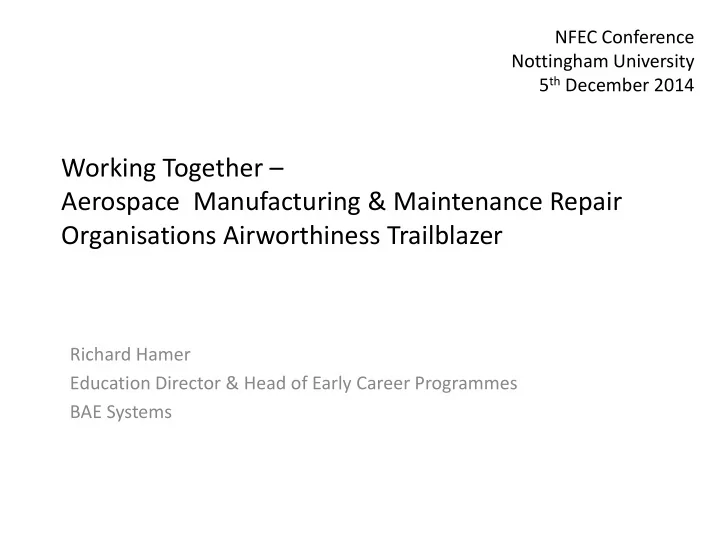

NFEC Conference Nottingham University 5 th December 2014 Working Together – Aerospace Manufacturing & Maintenance Repair Organisations Airworthiness Trailblazer Richard Hamer Education Director & Head of Early Career Programmes BAE Systems
Agenda 1) Introduction 2) Background to the Trailblazers 3) Trailblazer development 4) Challenges & successes 5) The future
1) Introduction • Who I am… background & experience • The company I work for… • The group I am representing… Aerospace & Aviation MRO/Airworthiness
2) Background to the Trailblazers • June 2012 - Government commissioned Doug Richard to undertake a review of Apprenticeships in England • November 2012 – Richard Review published • April 2013 – Rigour and Responsiveness in Skills (Raising standards, Traineeships, ensuring meaningful qualifications, responsive funding, reforming Apprenticeships) • October 2013 – Government published “The future of Apprenticeships in England - Implementation Plan” • November 2013 – Trailblazers Phase 1 commence • March 2014 – First Apprenticeship Standards published and Phase 2 launched, Guidance for Trailblazers • June 2014 – Phase 2 Standards published, Phase 3 launched September • Trailblazers will pave the way for full implementation of the reforms during 2015/16 and 2016/17 • All new Apprenticeship starts from 2017/18 will be on the new programme. • As the new standards are developed and agreed, the Government will cease funding Apprenticeships under former frameworks
2) Background continued – what are the main aims of the reforms? High quality Higher expectations of English and Maths, more assessment at end of Apprenticeship and introducing grading. Simple Employer driven Complex frameworks to Ensuring rigorous be replaced by standards training that will of around two pages support economic written by employers. growth
3) Trailblazer Development The Aerospace & Aviation MRO / Airworthiness Trailblazer Groups Employers: Agusta Westland, Airbus, AQMS, BAE Systems, BBGA ,Fly Virgin, Gama Aviation, GKN, GTA England, Gulf Stream, Harrods Aviation, Inflight, Magellan, Marshall Aero, MoD, Rizon Jet, Rolls Royce, Tag Aviation. Consulted and supported by : BIS, NFEC, Semta, Resource, CAA, Professional Engineering Institutions - Royal Aeronautical Society, IMechE, SOE, IET, Awarding Organisations – Pearson, EAL, City & Guilds
3) Aerospace Aircraft MRO Apprenticeship Standard Employer Endorsement Foundation Phase Development Phase Phase Skills Skills End of scheme assessment able to carry out a role as a skilled person within the Knowledge Knowledge business Behaviours Ensure meet EngTech Behaviours Off-the-job On-the-job Final period
3) Trailblazer Development - Apprenticeship Standards ‘Guiding Principles’ agreed… • Employer led • Common approach • Entry requirements • Structure of Apprenticeship • Split of assessment • Grading of Apprenticeships • Engineering Technician Standard • Devolved Administrations? • Advanced Manufacturing sector
3) Apprenticeship Trailblazer Standards Progress to date… Approved: • Aerospace Manufacturing Fitter / Technician Approved – subject to final amendment: • Aircraft Maintenance Fitter /Technician • Aerospace Manufacturing Electrical/Mechanical & Systems Fitter In development: • Maintenance Mechanic (Military) at Level 2 • Survival Equipment Fitter (Military) at Level 3 • Airworthiness Planning, Quality & Safety Technician at Level 3 • Aircraft Certifying Engineer at Level 4 (EASA Cat B Licences) • Aerospace Engineer at Level 4 to 6 • Aerospace Manufacturing Engineer at Level 4 to 6 • Aerospace Software Developer at Level 4 to 6 • Machinist at Level 3
4) Challenges • Keeping it concise – developing a 2 page Apprenticeship Standard • Agreeing on the content of the Standard • Achieving consensus • Opportunity/access? Ensuring wide and varied consultation with SMEs • Helping with BIS understanding of our sector, what will work • Evolving policy - being ‘inside the policy tent’ • Time constraints for the policy deployment and our time commitment
4) Successes • Creating a shared vision with BIS • Standard approved - creating a high quality standard something that is fit for purpose • Standards approved for development • Working on the basis of fit for SME first and build from there • Agreement on guiding principles • Incorporating EASA Part 66 Licences into Apprenticeships • Engagement with Professional Engineering Institutions • Alignment with EngTech • Consultation • Collaboration & true partnership
5) The Future What are the next steps? • Standards through a Gateway Process for all Apprenticeships • Advanced Manufacturing & Engineering – future governance and management of Standards on going maintenance • Deployment of the effective template for Standard s development • Identifying further occupations • Continuing review (3 yearly basis) • Further widening of employer participation • Further alignment with other groups e.g. AGP, DGP IPs
Thank you for your time & Questions
Recommend
More recommend